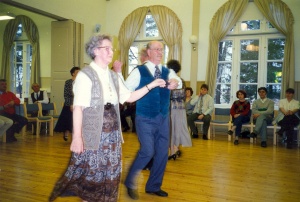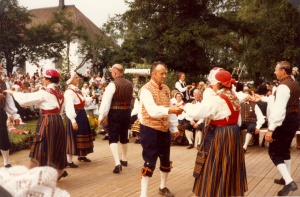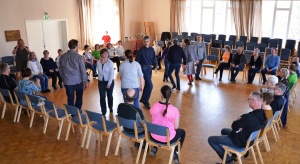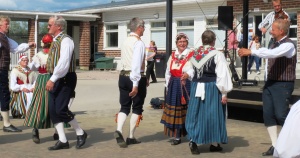The ‘purpuri’ dance in the Kokkola area
| The ‘purpuri’ dance in the Kokkola area | ||||
|---|---|---|---|---|
|
Practitioners and people who know the tradition well
The Kokkola area includes the parishes of Kokkola, Nedervetil, Terjärv and Kronoby in the north of Swedish-speaking Ostrobothnia. The dance “purpuri” (“potpourri”) retained an important role in these areas until the 1960s. Purpuri was danced on both ordinary days and during celebrations, including weddings, as a ceremonial dance and a social dance. It was common at large, three-day-long weddings. When weddings were held outdoors in the summer, a horn group provided the music.

In the early 1980s, a group of preservers of the tradition began work to uphold the purpuri tradition and perform it to audiences. Purpuri is a folk dance that was not traditionally danced in national costume, but when preservers of the tradition, including Greta and Bjarne Snåre in Kronoby and Anna-Lisa and Yngve Biskop in Kokkola, began performing in the costume, it became entwined with the tradition, and all those dancing it began wearing the traditional costume of their home district. As these preservers of the tradition grew older, a younger group formed in 2012 to keep the dance alive and spreading.
Nowadays, around 30 people meet regularly for purpuri dances once a month, to enjoy dancing together as well as to maintain the tradition. These dancers come from Kokkola, Kronoby, Jakobstad, Larsmo and Pedersöre. The dances are often accompanied by folk musicians from a range of different groups, or amateur folk musician organisations, under the leadership of Mikael Fröjdö. Modern-day purpuri dancers learnt the dance from older generations, and are now themselves preservers of the tradition.
The dance can be accompanied by several musicians, as well as a horn group on occasion. Kronoby Hornkapell (a horn septet) regularly accompany purpuri dances, led by Mikael Fröjdö, who learnt from the musicians of Kronoby Hornkapell. Fröjdö is also a violinist and was taught how to play the purpuri in his youth by older violinists in Kronoby, Kokkola, Nedervetil, Terjärv and Esse. When it comes to the music and playing, Fröjdö has absorbed the oral stories and instructions on style and performance that are not included in the sheet music.
Practising of the tradition
First of all, it must be emphasised that the purpuri is a very large and very long dance, and can be danced by any number of couples. How long the dance lasts depends on the number of couples dancing – the more people, the longer it will last.
The dance starts with the dancers sitting on benches along the walls of the dance hall. It then takes on a square formation. The dance is led by couple number one, who must know the figures and their order, and initiate them. When couple number one start a figure around the floor, the next couple get up and follow them. Some figures are started by two couples at the same time – couple number one and another couple sitting diagonally across from them, known as their vis-a-vis, whilst the rest of the dancers sit and wait their turn to start the figure. The purpuri offers dancers plenty of time to watch how the others manage the dance.
The purpuri today is danced with the following figures: 1) polonaise, 2) skip-pace, 3) as before with a different melody, 4) smooth waltz, 5) figuré, 6) skip-pace as in 2 but with another melody, this figure used to be danced twice, 7) march. The skip-pace and figuré parts are performed in the middle of the floor by two couples at a time in turn, by the couples sitting diagonally opposite in the dance hall. The final element is the thanking, where the couples sitting diagonally opposite each other meet in the middle of the floor and thank one another, two couples at a time.
In terms of style, and typically for the purpuri dance, it is danced as if those involved are not actually dancing. Bojen Huldén explained this aptly in 1977, when she described the style as follows: “And the bewildering element of absence, which only the most proficient and rhythmic could flaunt: they would dance as if not actually dancing, as if their feet and legs and arms were operating entirely of their own accord, whilst their mind was somewhere else entirely.” Those performing the dance stood apart from each other in terms of proficiency and character, those who led the purpuri were often called “stordansare” (“master dancers”). One such person was Storback-Alfred, who was a true master of the purpuri – present in rhythm, absent in mind. His legs had “at least two extra joints between the knee and ankle, and it was completely incomprehensible how they all could swing exactly in time, and without Alfred having to exert the slightest bit of effort,” explained Huldén. Dancers today try to retain this style.

The background and history of the tradition
The dance purpuri is a set of dances danced one after the other. Chain dances were given the name potpourri in France in the 18th century. The dance arrived in Finland from the east in the early 19th century and became popular amongst both the Swedish-speaking and Finnish-speaking populations. The bourgeoisie called the dance potpourri, whilst the country people termed it the purpuri.
In Oulu the potpourri was danced in 1809 when Russian troops were quartered in the town following the 1808–1809 war. Only women were invited to the first ball, so that the gentlemen who had moved there would have someone to dance with. In Helsinki it was danced from the 1820s onwards. When the university in Helsinki (now the University of Helsinki) celebrated its 200th anniversary in 1840, the dance programme included the potpourri.
Amongst the rural population, the purpuri became common during the latter part of the 19th century. In the coastal Swedish-speaking areas, the purpuri was generally danced in the western part of Uusimaa, in Åboland, and in the northern part of Swedish-speaking Ostrobothnia. In the early 20th century it became common for brass bands to provide the music at weddings, which were held outside during the summer, with a dancefloor built especially for the dance. The famous folk musician Lennart Witting (1880–1959) stated in 1945 that originally, the following figures formed the purpuri: polonaise in 3/4 pace, galop in 2/4, so-called fugure or figuré in 6/8, waltz, mazurka-galop in 3/4 (sometimes an additional galop was played in 2/4 after this), and finally another polonaise in 3/4 or a march in 2/4 or 4/4. The waltz was, and still is today, a smooth waltz.
The purpuri played a major role as a wedding dance right up until the 1950s. It was danced both as the first dance, known as the ceremonial dance, and as a general dance open to all. The first purpuri was danced only by the bridesmaids and groomsmen, who were the bridal couple’s unmarried friends and family. Before the first purpuri, the dancers were paired up by the bridal couple, who had drawn up a list of who should dance with whom, and the bridesmaids and groomsmen were called out.
The first purpuri was started with a very long polonaise, a walk around the floor in different formations, called ”roså” (swedish ros = eng. rouse). This was danced only by the bridesmaids and groomsmen, and after the “roså” the purpuri itself began, and was called the ”rospurpuri”.The newlyweds did not always partake in the “roså”, but instead danced as the first couple in the “rospurpuri”, with the first couple amongst the bridesmaids and groomsmen as their vis-a-vis. If the groom, who would normally lead the “rospurpuri”, was not a keen dancer, he could delegate this role. The “rospurpuri” was danced in a solemn atmosphere, to please God, silently and calmly. If the “rospurpuri” was completed satisfactorily, the reputation of the wedding would be preserved.
The “rospurpuri” could last the entire first day of the wedding, as there could be a hundred or more bridesmaids and groomsmen. During a three-day wedding, it was common for three purpuris to be danced. All of the wedding guests took part in the two other purpuris, when the dance was ”public”.The dancers ate and drank coffee between the figures, and could also dance other dances, fashion dances, in between, before continuing with the next purpuri figure. The purpuri as a public dance was danced with calls – people ”hujkade”, or shouted out – when they met a couple they were fond of or good friends with, or if they thought the girl and boy would be well-suited to each other.

The transmission of the tradition
In the Kokkola area the purpuri was the principal dance long into the 1950s. Prior to the wedding, the young people would gather together with some adults to practise before the exciting opportunity to participate in the “rospurpuri”. During work that requires waiting for periods, such as firing bricks, with the firing requiring supervision for the entirety of its three-day duration, those present could dance the purpuri, with even the priest partaking. All generations danced together when it came to the purpuri. Children learnt by watching the adults dancing. Children of seven or eight years old could already dance just as well as the adults. The purpuri was also danced at ”child weddings”, which involved a dance performance with a child dressed as a pretend bride, where adults and children gathered funds for a poor family by paying for the dance.
When the purpuri became popular amongst the upper class in the 19th century, the dance was often led by a leader or dance teacher, who called out the figures. In rural society no one called out the figures, and instead the man of couple number one took on the role of leader, and knew the dance and the order of the figures. This tradition has remained intact today. The key figures in the purpuri dance tradition during the latter part of the 20th century included Johan ”Jussi” Björk and Anna-Lisa and Yngve Biskop in Kokkola, Greta and Bjarne Snåre in Kronoby, and Bruno and Greta Högnabba and Gunnar and Gunvor Kolam in Terjärv.
As well as still being danced today as part of a living tradition, the dance is also well-documented. The first records date to the 1910s, and were made by Kokkola natives living in Helsinki. When dance researcher Yngvar Heikel made records of the dances in Swedish-speaking Finland in the 1920s, he was able to describe in detail how the purpuri was danced in different parishes. The dance varied from area to area. In 1971, engineer Kim Hahnsson began to document dances on film, including the purpuris danced in Swedish-speaking Finland. He filmed the purpuri in Kronoby in 1977, and two years later the then archivist at the Society of Swedish Literature in Finland, Ann-Mari Häggman, recorded the same purpuri on film.
In general, the purpuri is danced in its entirety for fun only in social contexts where a large number of people have gathered together, to celebrate something, for example. These events are open to the public.
The purpuri is not danced as a performance, as it is too long and time-consuming. When the purpuri is danced in front of audiences nowadays, it is danced in a shortened form. Some repeated figures are left out, whilst others traditionally danced by two couples at a time are danced instead by four couples at a time. This allows the dance to be shortened. Purpuri dancers dance regularly in different locations, including at Kaustinen Folk Music Festival. At such events, people often wear national costumes.

Kronoby Hornkapell regularly accompany purpuri dances, led by Mikael Fröjdö, The group perform purpuri music at concerts as well as accompanying the purpuri dance on special occasions.
The future of the tradition
People passionate about folk traditions play a significant role in keeping them alive. When it comes to the purpuri, there has always been someone playing a leading role throughout history, and the same is still true today. In the Kokkola area, the leader, folk musician and fiddle player Mikael Fröjdö, occupies a key position. As new players get involved with Kronoby hornkapell, they learn about purpuri music. The aim is to keep the purpuri alive, both through music and through dance, in a fun way. When it comes to the dance itself, and knowledge of the figures and their order, the leading couple and their vis-a-vis place a crucial role. Today, that duty lies with Harriet and Peter Bäck. They have learnt all they know from the previous generation. Events at which the purpuri is danced are always open to new dancers, who can learn by watching how the other couples dance. The purpuri dance in the Kokkola area remains a living tradition today.
The community/communities behind this submission.
Purpuridansarna i Karlebynejden
Bibliography and links to external sources of information
Recordings:
Karlebynejdens Spelmansgille. LP-skriva 1980.
Filmupptagningar av Kim Hahnsson (FMI 230) och Ann-Mari Häggmani (SLS 1368).
SLS 1368 Youtube: Dokumentation av purpuri i Kronoby 1979
Litterature:
Ala-Könni, Erkki 1986: Suomen Kansanmusiikki. Tutkielmia neljältä vuosikymmeneltä. Kaustinen: Kansanmusiikki-instituutti.
Biskop, Gunnel 2008: Purpuri - att dansa Gudi till behag. Folkdansforskning i Norden. Nordisk forening for folkedansforskning.
Biskop, Gunnel 2016: Purpuri - att dansa på golvet som Herran dig gav. Helsingfors: Folkdansaren nr 1. Finlands Svenska Folkdansring.
Heikel, Yngvar 1938: Dansbeskrivningar. Finlands svenska folkdiktning. Helsingfors: Svenska litteratursällskapet i Finland, 268.
Huldén, Bojen 1977: Det gäller att dansa med andakt på golvet som Herren dig gav. Huvudstadsbladet, den 3 april.
Nikula, Heikki 2013: Häämusiikkia kielirajalla - bröllopsmusik vid språkgränsen. Kaustinen: Kansanmusiikki-instituutti.
Rausmaa, Pirkko-Liisa 1999: Purpuri suomalaisessa tanssiperinteessä - Suomalainen purpuri. Toim. Kari Bergholm. Helsinki: Suomalaisen Kansantanssin Ystävät.
